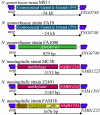Microarray genomotyping of key experimental strains of Neisseria gonorrhoeae reveals gene complement diversity and five new neisserial genes associated with Minimal Mobile Elements
- PMID: 15084227
- PMCID: PMC406496
- DOI: 10.1186/1471-2164-5-23
Microarray genomotyping of key experimental strains of Neisseria gonorrhoeae reveals gene complement diversity and five new neisserial genes associated with Minimal Mobile Elements
Abstract
Background: There are four widely used experimental strains of N. gonorrhoeae, one of which has been sequenced and used as the basis for the construction of a multi-strain, mutli-species pan-neisserial microarray. Although the N. gonorrhoeae population structure is thought to be less diverse than N. meningitidis, there are some recognized gene-complement differences between strains, including the 59 genes of the Gonococcal Genetic Island. In this study we have investigated the three experimental strains that have not been sequenced to determine the extent and nature of their similarities and differences.
Results: Using the Pan-Neisseria microarray, three commonly used gonococcal laboratory experimental strains were investigated (F62, MS11, & FA19). Genes absent from these strains, but present in strain FA1090, were assessed as is possible with typical microarrays. Due to the design of this microarray, additional genes were also identified. Differences were associated with Minimal Mobile Elements (MMEs) or known divergences. Genomotyping indicates the presence of genes previously only described in meningococci and shows the presence of the complete Gonococcal Genetic Island in N. gonorrhoeae strain FA19. Five new neisserial genes were identified through microarray genomotyping and subsequent sequencing of two divergent MMEs in N. gonorrhoeae strain MS11 and four MMEs in N. gonorrhoeae strain FA19. No differences were identified between N. gonorrhoeae strains FA1090 and F62, indicating that these strains are very similar.
Conclusion: This study shows extensive similarity between the experimental strains, associated with a varying number of strain-specific genes. This provides a framework for those working with these strains to refer to the available gonococcal genome sequence, and is the first detailed comparison of gene complements between gonococcal strains.
Figures







Similar articles
-
Strain-specific differences in Neisseria gonorrhoeae associated with the phase variable gene repertoire.BMC Microbiol. 2005 Apr 27;5:21. doi: 10.1186/1471-2180-5-21. BMC Microbiol. 2005. PMID: 15857514 Free PMC article.
-
Complete and variant forms of the 'gonococcal genetic island' in Neisseria meningitidis.Microbiology (Reading). 2005 Dec;151(Pt 12):4005-4013. doi: 10.1099/mic.0.27925-0. Microbiology (Reading). 2005. PMID: 16339945
-
Comparative analysis of two Neisseria gonorrhoeae genome sequences reveals evidence of mobilization of Correia Repeat Enclosed Elements and their role in regulation.BMC Genomics. 2009 Feb 9;10:70. doi: 10.1186/1471-2164-10-70. BMC Genomics. 2009. PMID: 19203353 Free PMC article.
-
Mobile genetic elements in Neisseria gonorrhoeae: movement for change.Pathog Dis. 2017 Aug 31;75(6). doi: 10.1093/femspd/ftx071. Pathog Dis. 2017. PMID: 28645177 Review.
-
Natural transformation of Neisseria gonorrhoeae: from DNA donation to homologous recombination.Mol Microbiol. 2006 Jan;59(2):376-85. doi: 10.1111/j.1365-2958.2005.04964.x. Mol Microbiol. 2006. PMID: 16390436 Review.
Cited by
-
Review and international recommendation of methods for typing neisseria gonorrhoeae isolates and their implications for improved knowledge of gonococcal epidemiology, treatment, and biology.Clin Microbiol Rev. 2011 Jul;24(3):447-58. doi: 10.1128/CMR.00040-10. Clin Microbiol Rev. 2011. PMID: 21734242 Free PMC article. Review.
-
DNA uptake sequences in Neisseria gonorrhoeae as intrinsic transcriptional terminators and markers of horizontal gene transfer.Microb Genom. 2016 Aug 25;2(8):e000069. doi: 10.1099/mgen.0.000069. eCollection 2016 Aug. Microb Genom. 2016. PMID: 28348864 Free PMC article.
-
The small FNR regulon of Neisseria gonorrhoeae: comparison with the larger Escherichia coli FNR regulon and interaction with the NarQ-NarP regulon.BMC Genomics. 2007 Jan 29;8:35. doi: 10.1186/1471-2164-8-35. BMC Genomics. 2007. PMID: 17261178 Free PMC article.
-
Neisseria gonorrhoeae subverts formin-dependent actin polymerization to colonize human macrophages.PLoS Pathog. 2021 Dec 28;17(12):e1010184. doi: 10.1371/journal.ppat.1010184. eCollection 2021 Dec. PLoS Pathog. 2021. PMID: 34962968 Free PMC article.
-
Strain-specific differences in Neisseria gonorrhoeae associated with the phase variable gene repertoire.BMC Microbiol. 2005 Apr 27;5:21. doi: 10.1186/1471-2180-5-21. BMC Microbiol. 2005. PMID: 15857514 Free PMC article.
References
-
- Spratt BG, Smith NH, Zhou J, O'Rourke M, Feil E. The population genetics of the pathogenic Neisseria. In: Baumberg S, Young JPW, Wellington EMH and Saunders JR, editor. Society for General Microbiology. Vol. 52. SGM Press; 1995. pp. 143–160.
-
- O'Rourke M, Stevens E. Genetic structure of Neisseria gonorrhoeae populations: a non-clonal pathogen. J Gen Microbiol. 1993;139 ( Pt 11):2603–2611. - PubMed
-
- O'Rourke M, Spratt BG. Further evidence for the non-clonal population structure of Neisseria gonorrhoeae: extensive genetic diversity within isolates of the same electrophoretic type. Microbiology. 1994;140 ( Pt 6):1285–1290. - PubMed
-
- De La Fuente L, Vazquez JA. Genetic structures of non-penicillinase-producing Neisseria gonorrhoeae strains in relation to auxotype and serovar class. J Infect Dis. 1994;170:696–700. - PubMed
Publication types
MeSH terms
Substances
Associated data
- Actions
- Actions
- Actions
- Actions
- Actions
- Actions
Grants and funding
LinkOut - more resources
Full Text Sources
Other Literature Sources

